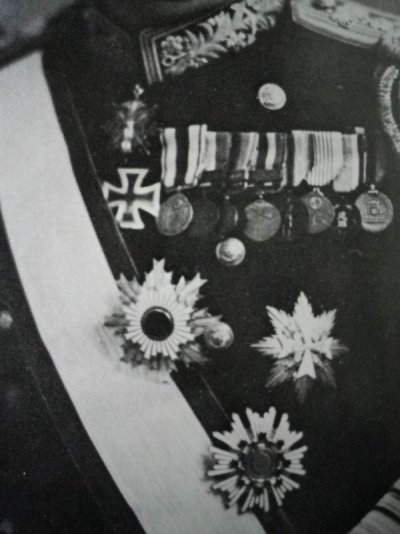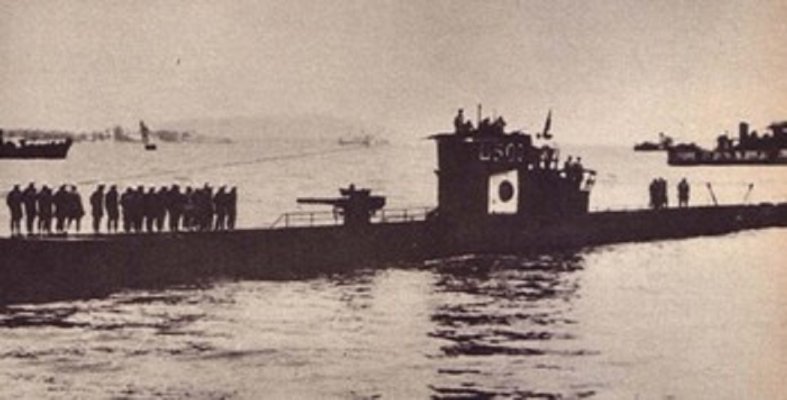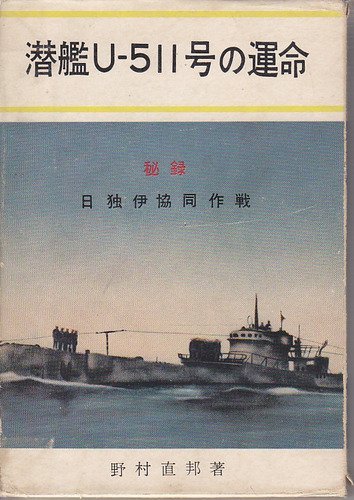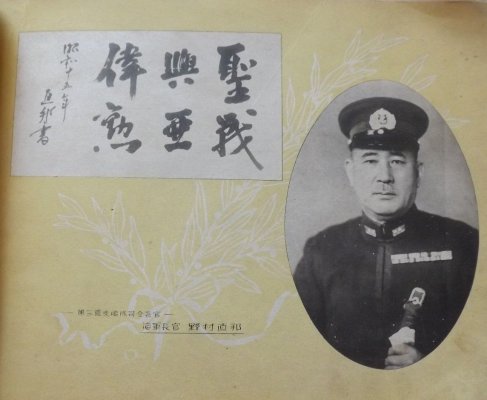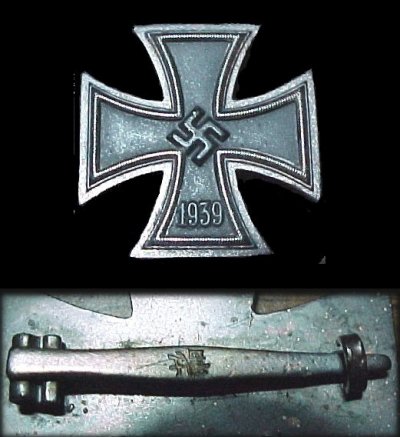Вы используете устаревший браузер. Этот и другие сайты могут отображаться в нём некорректно.
Вам необходимо обновить браузер или попробовать использовать другой.
Вам необходимо обновить браузер или попробовать использовать другой.
EK-I для японского адмирала
- Автор темы JapanX
- Дата начала
Номура Наокуни (15.5.1885 - 12.12.1973), японский военно-морской деятель, адмирал (1.3.1944). Окончил Военно-морское училище (1907) и Военно-морскую академию. Службу начал 20.11.1907 мичманом на крейсере «Ицукусима». Служил на различных надводных кораблях (в 1916-17 командовал эсминцем «Сиракумо»), с 1917 - на штабных должностях. В 1922-24 находился в командировке в Германии. С10.12.1928 командир тендера подводных лодок «Тогей». 1.5.1929 назначен военно-морским атташе в Берлине. С нояб. 1929 по июнь 1931 делегат от Японии на Лондонской морской конференции. С 10.10.1931 командир тяжелого крейсера «Хагуро», 24.2-20.10.1933 - авианосного крейсера «Kara». С 15.11.1933 начальник школы подводного флота. 15.11.1934 поставлен во главе 2-й подводной эскадры, а 15.11.1935 возглавил штаб Объединенного и 1-го флотов. С 1.12.1936 начальник 3-го (разведывательного) управления Морского Генштаба. С 25.4.1938 по 26.10.1939 военно-морской атташе в Китае, один из активных пропагандистов и организаторов японской экспансии в этом регионе. С 15.11.1939 по 30.9.1940 командовал 3-м Китайским экспедиционным флотом, дислоцированным в портах Маньчжурии и Северного Китая. С 13.11.1940 по 1.3.1943 находился в Европе в качестве военно-морского представителя Японии при Верховном командовании стран «оси». С 9.8.1943 военно-морской советник. С 20.10.1943 командующий военно-морской базой в Куре. 17.7.1944 поддавлением правящих кругов X. Тод-зио назначил Н. военно-морским министром, но уже 24 июля он сложил с себя полномочия и вновь назначен военно-морским советником. С 2 авг. по 15 сент. 1944 командующий военно-морской базой в Йокосуке. С 15.9.1944 командующий эскортным флотом. 1.5.1945 в третий раз стал военно-морским советником императора, а 15.10.1945 был переведен в резерв.
Источник: Залесский К.А. Кто был кто во второй мировой войне. Союзники Германии. Москва, 2003
Об адмирале в английской вики
https://en.wikipedia.org/wiki/Naokuni_Nomura
в японской
https://ja.wikipedia.org/wiki/野村直邦
Источник: Залесский К.А. Кто был кто во второй мировой войне. Союзники Германии. Москва, 2003
Об адмирале в английской вики
https://en.wikipedia.org/wiki/Naokuni_Nomura
в японской
https://ja.wikipedia.org/wiki/野村直邦
Сотрудничество между Германией и Японией становилось все теснее не только в политической, но и в военной области. Из секретных сообщений наших агентов в Германии мы узнали, что туда посылается огромная японская военная миссия, но особенно меня удивил тот факт, что ее возглавлял адмирал японского флота, второй Номура, Наокуни Номура. Таким образом, Япония вела двойную игру: одного Номура послали в США с разговорами о мире, а другого — в Германию обсудить вопросы войны. По сообщению наших агентов, Наокуни Номура не держал в секрете своих симпатий. Фактически его действия в рейхе указывали на то, что он рассматривал себя активным союзником немцев в их войне против Англии. Он даже участвовал в одной боевой операции немецкой подводной лодки и временно командовал лодкой во время потопления английского торгового судна, причем нападение было совершено без предупреждения. В какой-то мере эта поездка явилась торговой вылазкой: японцы стремились закупить как можно больше немецких военных изобретений и новых видов секретного оружия. Нацисты, надеясь сделать из японцев активных, но нейтральных союзников, стали кредиторами последних, открыв перед ними свои арсеналы, и снабдили японцев всем, чего те желали. Список закупок, сделанных Наокуни Номура, говорил сам за себя: эти закупки не предназначались для мирной экономики — они предвещали скорую войну.
Источник
Источник
Вложения
U-511 — большая океанская немецкая подводная лодка типа IX-C, времён Второй мировой войны. Заказ на постройку лодки был отдан судостроительной компании «Дойче Верке» в Гамбурге 20 октября 1939 года. Лодка была заложена 21 февраля 1941 года под строительным номером 307, спущена на воду 22 сентября 1941 года, 8 декабря 1941 года под командованием капитан-лейтенанта Фридриха Штейнхоффа вошла в состав учебной 4-й флотилии. 1 августа 1942 года вошла в состав 10-й флотилии. Лодка совершила 4 боевых похода, в которых потопила 5 судов (41 373 брт) и повредила одно судно (8 773 брт). 16 сентября 1943 года была продана японцам и стала японской субмариной RO-500. В августе 1945 года капитулировала в Майдзуру.
См. также: https://en.wikipedia.org/wiki/German_submarine_U-511 и https://ru.wikipedia.org/wiki/U-511
См. также: https://en.wikipedia.org/wiki/German_submarine_U-511 и https://ru.wikipedia.org/wiki/U-511
Орла он получает 17 мая 1943 года за содействие сотрудничеству между Японией и Германией.
昭和十八年六月二日付
「グロースクロイツ、アードレル」勲章
海軍中将 野村直邦
軍令部出仕兼海軍省出仕、日独親善関係増進に寄与、
一九四三年五月十七日証明
А железный крест первого класса 19 октября 1943-го года с той же формулировкой
昭和十九年八月十日付
第一級鉄十字章
海軍中将 野村直邦
軍令部出仕兼海軍省出仕として日独親善に尽力
一九四三年十月十九日証明
昭和十八年六月二日付
「グロースクロイツ、アードレル」勲章
海軍中将 野村直邦
軍令部出仕兼海軍省出仕、日独親善関係増進に寄与、
一九四三年五月十七日証明
А железный крест первого класса 19 октября 1943-го года с той же формулировкой
昭和十九年八月十日付
第一級鉄十字章
海軍中将 野村直邦
軍令部出仕兼海軍省出仕として日独親善に尽力
一九四三年十月十九日証明
Alex Ponomarev
Модератор
Эта Номура совершила переход из Германии в Японию на подводной лодке U-511.
За этот переход весь экипаж был награждён, видимо Номура тоже, как член экипажа.
А вот такие ЕК1-1939 изготавливали в Японии для немецких моряков, возможно и у японца такой был.
За этот переход весь экипаж был награждён, видимо Номура тоже, как член экипажа.
А вот такие ЕК1-1939 изготавливали в Японии для немецких моряков, возможно и у японца такой был.
Вложения
Эта Номура совершила переход из Германии в Японию на подводной лодке U-511.
Алекс, посмотри посты чуть выше

А вот такие ЕК1-1939 изготавливали в Японии для немецких моряков, возможно и у японца такой был.
Кресты эти известны (я по ним когда-то и тему даже делал на каком-то форуме), да только не особенно похоже, чтобы у адмирала был именно такой крест. Впрочем, по такому фото сложно о чём-либо судить с уверенностью.
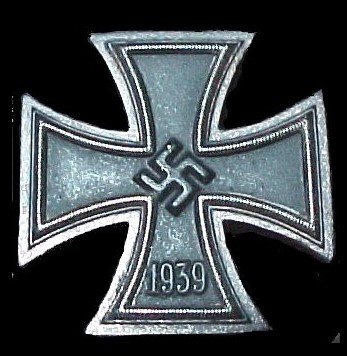
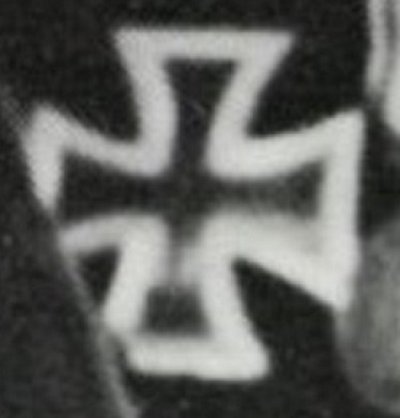
Последнее редактирование модератором:
Alex Ponomarev
Модератор
...
Кресты эти известны (я по ним когда-то и тему даже делал на каком-то форуме), ...
Так и нам сделай.
Я не видел этой темы на каком-то форуме.

Писал я тогда кажется о "японских" Kriegsabzeichen für Hilfskreuzer и в ходе обсуждения были помянуты и эти крестики.
Только я хочу заметить, что по легенде эти кресты изготавливались в Токио для немцев.
У тебя есть экземпляр Уильямсона?

Если есть, то может быть сделаешь скан страницы 133, где он презентует японский EK-I, которым был награждён Oberbootsmannsmaaat Conrad Metzner?
Только я хочу заметить, что по легенде эти кресты изготавливались в Токио для немцев.
У тебя есть экземпляр Уильямсона?

Если есть, то может быть сделаешь скан страницы 133, где он презентует японский EK-I, которым был награждён Oberbootsmannsmaaat Conrad Metzner?
Alex Ponomarev
Модератор
Так и о "японских" Kriegsabzeichen für Hilfskreuzer расскажи.
Я вообще про такие не слышал.
Я вообще про такие не слышал.

Добавлю ещё этот интересный материал http://www.combinedfleet.com/RO-500.htm
21 February 1941:
Hamburg, Germany. A 1,120-ton (surfaced) type IXC U-boat, is laid down at Deutsche Werft AG.
22 September 1941:
Launched and numbered U-511.
8 December 1941:
Completed and commissioned in the Kriegsmarine. Kapitänleutnant Friedrich Steinhoff is the Commanding Officer.
31 May-5 June 1942:
Peenemünde, Germany. Steinhoff and his brother Dr. Ernst Steinhoff, an engineer at the Peenemünde rocket development facility, discuss the feasibility of firing an artillery rocket from the deck of a submerged submarine. During the summer, U-511 is used for rocket tests on the Baltic coast of Germany. A rack for six 30-cm Wurfkörper 42 Sprengraketen rockets is installed. Tests are carried out, including a successful launch of the rockets from a depth of 12 meters.
Vizeadmiral Karl Dönitz, Befehlshaber der Unterseeboote (BdU) (CINC, U-boats), approves the concept of launching the rockets against New York City, but the plan is delayed for technical reasons and is eventually cancelled.
August 1942-July 1943:
U-511 sinks five ships for a total of 41, 373 tons and damages an 8,773-ton tanker. [1]
18 December 1942:
Kapitänleutnant Fritz Schneewind assumes command. Steinhoff later becomes the CO of U-873.
26 February 1943:
Vinnitsa, Ukraine. During a conference with Dönitz in Führer’s HQ, Hitler makes the final decision about the transfer of two Kriegsmarine U-boats to Japan in order to launch a full-scale campaign against Allied communications in the Indian Ocean. Dönitz opposes the idea, but is quickly overruled.
3 March 1943:
Vice Admiral Nomura Naokuni (35)(former CO of KAGA), Japan's representative to the Axis Tripartite Commission in Berlin since 1941, is ordered to return to Japan on the next outgoing submarine. Japanese naval attaché Rear Admiral Yokoi Tadao (former CO of CHIYODA) also authorizes the departure of Maj Sugita Tamotsu of the IJA Medical Service, who had been studying in Germany.
Late April 1943:
Vice Admiral Nomura and Maj Sugita are invited to a farewell party in Hitler’s Berlin residence. During that party Field Marshal Wilhelm Keitel, Chief of the German Wehrmacht, personally authorizes export of Daimler-Benz MB-518 diesel engines for use on Japanese torpedo boats. The first example is sent to Lorient, France, for embarkation on U-511.
10 May 1943:
Lorient, France. Early in the morning, Vice Admiral Nomura and Maj Sugita arrive by train from Berlin. After 1300, U-511 ("Marco Polo 1") departs for Penang, Malaya. U-511 also carries a full set of Messerschmitt Me-163 "Komet” rocket interceptor blueprints, samples of yellow fever vaccine, spare torpedoes and supplies for the German U-boat "Gruppe Monsun" (Monsoon) being organized at Penang. [2]
U-511 carries a crew of 49 and nine passengers - five Germans and four Japanese. Among the Japanese are Vice Admiral Nomura and Major Sugita. The Germans include Dr. Ernst Wörmann, ambassador to Wang Jing-we's pro-Japanese collaborationist government at Nanking, China and Franz-Joseph Spahn, en route to Japan as an "overseer" for the Jewish refugee policy in Manila and three engineers from U-boat builder Deschimag AG Weser at Bremen: Mssrs. Herberlein, an auxiliary engine specialist Hans Schmidt, a welding technician, and Müller of the Type IXC construction office.
During transit, U-511 is designated by the Japanese as "Satsuki (Month of First Buds) No. 1."
22 May 1943:
W of Freetown, Liberia, Africa. U-511 makes a planned rendezvous with Kapitänleutnant Ebe Schnoor's U-460, a Type XIV "Milchkuh" (Milk Cow) tanker. U-511 takes on fuel and provisions. After refueling U-511, U-460 departs for France arriving on 25 June. U-511 heads for the Indian Ocean.
27 May 1943:
U-511, travelling at an average submerged speed of 3 knots, crosses the equator.
10 June 1943:
U-511 enters the Indian Ocean.
27 June 1943:
Indian Ocean. U-511 torpedoes 7,194-ton American "Liberty" ship SEBASTIAN CERMENO en route from Mombasa, Kenya to Bahia, Brazil. She sinks at 28-50S, 50-20E. Schneewind surfaces to question survivors, then submerges and retires from the area.
9 July 1943:
Indian Ocean. U-511 torpedoes 7,176-ton American Liberty ship SAMUEL HEINTZELMAN en route from Fremantle, Australia via Colombo, Ceylon to Calcutta, India, loaded with 5,644-tons of ammunition. When the torpedoes hit the ship, she disintegrates in a massive explosion! The entire crew of 75 perishes. She sinks at 09-00S, 81-00E.
15 July 1943:
Andaman Sea. At the appointed time, U-511 makes a rendezvous with minelayer HATSUTAKA attached to the First Southern Expeditionary Fleet. Vice Admiral Nomura and Major Sugita briefly visit HATSUTAKA for a bath and then return to the U-boat.
16 July 1943:
Penang, Malaya. U-511 is the first German U-boat to arrive at the base. It subsequently becomes home for the "Monsun" Group. Admiral Nomura disembarks and he and the other Japanese continue on to Japan by air. Schneewind embarks a group of IJN officers including Lt Honda Yoshikuni (former navigating officer of I-17 and future CO of RO-41). [3]
24 July 1943:
At 1600, U-511 departs Penang for Kure.[4]
29 July 1943:
At 1650, the surfaced U-511 encounters Singapore-bound convoy HI-03 consisting of ARIMASAN, ASAMA, AWA and NANKAI MARUs and tanker OMUROSAN MARU. The convoy is escorted by kaibokan ETOROFU. The sighting of a strange-looking submarine causes confusion aboard OMUROSAN MARU and her gunners fire three shells at U-511, before the mistake is cleared up. The skipper of ETOROFU inspects U-511 and personally apologizes for the attack. [5]
5 August 1943:
Off the Bungo Suido (Strait). At 0800 U-55 rendezvouses with minelayer NUWAJIMA appointed to escort her for the remainder of voyage. Soon thereafter, a Japanese patrol aircraft reports the sighting of a submarine en route of U-511. NUWAJIMA conducts a depth-charge attack, while Schneewind continues the voyage independently. U-511 and NUWAJIMA stop at Agenosho Bay off Yashiro Jima for the night.
21 February 1941:
Hamburg, Germany. A 1,120-ton (surfaced) type IXC U-boat, is laid down at Deutsche Werft AG.
22 September 1941:
Launched and numbered U-511.
8 December 1941:
Completed and commissioned in the Kriegsmarine. Kapitänleutnant Friedrich Steinhoff is the Commanding Officer.
31 May-5 June 1942:
Peenemünde, Germany. Steinhoff and his brother Dr. Ernst Steinhoff, an engineer at the Peenemünde rocket development facility, discuss the feasibility of firing an artillery rocket from the deck of a submerged submarine. During the summer, U-511 is used for rocket tests on the Baltic coast of Germany. A rack for six 30-cm Wurfkörper 42 Sprengraketen rockets is installed. Tests are carried out, including a successful launch of the rockets from a depth of 12 meters.
Vizeadmiral Karl Dönitz, Befehlshaber der Unterseeboote (BdU) (CINC, U-boats), approves the concept of launching the rockets against New York City, but the plan is delayed for technical reasons and is eventually cancelled.
August 1942-July 1943:
U-511 sinks five ships for a total of 41, 373 tons and damages an 8,773-ton tanker. [1]
18 December 1942:
Kapitänleutnant Fritz Schneewind assumes command. Steinhoff later becomes the CO of U-873.
26 February 1943:
Vinnitsa, Ukraine. During a conference with Dönitz in Führer’s HQ, Hitler makes the final decision about the transfer of two Kriegsmarine U-boats to Japan in order to launch a full-scale campaign against Allied communications in the Indian Ocean. Dönitz opposes the idea, but is quickly overruled.
3 March 1943:
Vice Admiral Nomura Naokuni (35)(former CO of KAGA), Japan's representative to the Axis Tripartite Commission in Berlin since 1941, is ordered to return to Japan on the next outgoing submarine. Japanese naval attaché Rear Admiral Yokoi Tadao (former CO of CHIYODA) also authorizes the departure of Maj Sugita Tamotsu of the IJA Medical Service, who had been studying in Germany.
Late April 1943:
Vice Admiral Nomura and Maj Sugita are invited to a farewell party in Hitler’s Berlin residence. During that party Field Marshal Wilhelm Keitel, Chief of the German Wehrmacht, personally authorizes export of Daimler-Benz MB-518 diesel engines for use on Japanese torpedo boats. The first example is sent to Lorient, France, for embarkation on U-511.
10 May 1943:
Lorient, France. Early in the morning, Vice Admiral Nomura and Maj Sugita arrive by train from Berlin. After 1300, U-511 ("Marco Polo 1") departs for Penang, Malaya. U-511 also carries a full set of Messerschmitt Me-163 "Komet” rocket interceptor blueprints, samples of yellow fever vaccine, spare torpedoes and supplies for the German U-boat "Gruppe Monsun" (Monsoon) being organized at Penang. [2]
U-511 carries a crew of 49 and nine passengers - five Germans and four Japanese. Among the Japanese are Vice Admiral Nomura and Major Sugita. The Germans include Dr. Ernst Wörmann, ambassador to Wang Jing-we's pro-Japanese collaborationist government at Nanking, China and Franz-Joseph Spahn, en route to Japan as an "overseer" for the Jewish refugee policy in Manila and three engineers from U-boat builder Deschimag AG Weser at Bremen: Mssrs. Herberlein, an auxiliary engine specialist Hans Schmidt, a welding technician, and Müller of the Type IXC construction office.
During transit, U-511 is designated by the Japanese as "Satsuki (Month of First Buds) No. 1."
22 May 1943:
W of Freetown, Liberia, Africa. U-511 makes a planned rendezvous with Kapitänleutnant Ebe Schnoor's U-460, a Type XIV "Milchkuh" (Milk Cow) tanker. U-511 takes on fuel and provisions. After refueling U-511, U-460 departs for France arriving on 25 June. U-511 heads for the Indian Ocean.
27 May 1943:
U-511, travelling at an average submerged speed of 3 knots, crosses the equator.
10 June 1943:
U-511 enters the Indian Ocean.
27 June 1943:
Indian Ocean. U-511 torpedoes 7,194-ton American "Liberty" ship SEBASTIAN CERMENO en route from Mombasa, Kenya to Bahia, Brazil. She sinks at 28-50S, 50-20E. Schneewind surfaces to question survivors, then submerges and retires from the area.
9 July 1943:
Indian Ocean. U-511 torpedoes 7,176-ton American Liberty ship SAMUEL HEINTZELMAN en route from Fremantle, Australia via Colombo, Ceylon to Calcutta, India, loaded with 5,644-tons of ammunition. When the torpedoes hit the ship, she disintegrates in a massive explosion! The entire crew of 75 perishes. She sinks at 09-00S, 81-00E.
15 July 1943:
Andaman Sea. At the appointed time, U-511 makes a rendezvous with minelayer HATSUTAKA attached to the First Southern Expeditionary Fleet. Vice Admiral Nomura and Major Sugita briefly visit HATSUTAKA for a bath and then return to the U-boat.
16 July 1943:
Penang, Malaya. U-511 is the first German U-boat to arrive at the base. It subsequently becomes home for the "Monsun" Group. Admiral Nomura disembarks and he and the other Japanese continue on to Japan by air. Schneewind embarks a group of IJN officers including Lt Honda Yoshikuni (former navigating officer of I-17 and future CO of RO-41). [3]
24 July 1943:
At 1600, U-511 departs Penang for Kure.[4]
29 July 1943:
At 1650, the surfaced U-511 encounters Singapore-bound convoy HI-03 consisting of ARIMASAN, ASAMA, AWA and NANKAI MARUs and tanker OMUROSAN MARU. The convoy is escorted by kaibokan ETOROFU. The sighting of a strange-looking submarine causes confusion aboard OMUROSAN MARU and her gunners fire three shells at U-511, before the mistake is cleared up. The skipper of ETOROFU inspects U-511 and personally apologizes for the attack. [5]
5 August 1943:
Off the Bungo Suido (Strait). At 0800 U-55 rendezvouses with minelayer NUWAJIMA appointed to escort her for the remainder of voyage. Soon thereafter, a Japanese patrol aircraft reports the sighting of a submarine en route of U-511. NUWAJIMA conducts a depth-charge attack, while Schneewind continues the voyage independently. U-511 and NUWAJIMA stop at Agenosho Bay off Yashiro Jima for the night.
7 August 1943:
Kure. U-511 arrives. Kapitänleutnant Schneewind and his crew are hosted by the CO of the Kure Naval Base, Vice Admiral (Admiral, posthumously) Nagumo Chuichi (36)(former CO of YAMASHIRO). Schneewind and several officers later travel to Tokyo, where they receive decorations from Navy Minister Admiral Shimada Shigetaro (32)(former CO of HIEI) and Chief of the NGS, Fleet Admiral Nagano Osami (28)(former CO of HIRADO).
16 September 1943:
Kure. U-511 is formally handed over, commissioned in the IJN as RO-500 and attached to Kure Naval District. LtCdr Taoka Kiyoshi (55)(former CO of I-54) is the Commanding Officer. [5]
Kure. RO-500 is put through trials and evaluated by a team of IJN engineers led by Constructor Vice Admiral Fukuda Keiji, one of the designers of the YAMATO class battleships. The IJN team is assisted by three German engineers attached to the Naval Technical Institute in Tokyo. After careful study, the engineers point out several shortcomings of the IXC design, such as low underwater speed, unreliable diesel engines, inadequate ventilation and cooling equipment and limited range.
Earlier, a proposition was put forward to launch serial production of Type IXC submarines equipped with Japanese powerplants and weapons (tentatively designated as IXK by the Germans). Vice Admiral Fukuda rejects the proposition and instead recommends that all available resources be devoted to construction of the new I-201-class ("Sen Taka") high underwater speed submarines. Several features of U-511 are used in this design, including the electric welded pressure hull, prefabricated hull section, and re-designed engine mountings to reduce vibration and engine noise.
Late September 1943:
Kure. After teaching handling of the U-boat to the Japanese, U-511's German crew departs aboard the Italian freighter OSORNO bound for Singapore. Later, the crewmen make their way to Penang. [6]
1 November 1943:
RO-500 is attached to the Otake Submarine School for testing and training purposes.
3 December 1943:
LtCdr Taoka is attached to Headquarters, Sixth Fleet. RO-500's torpedo officer Lt Uesugi Sadao (65)(former torpedo officer of I-20) is appointed the acting CO of RO-500.
31 January 1944:
RO-500's torpedo officer Lt Yamazaki Toshio (67) is appointed the acting CO of RO-500.
30 April 1944:
Lt (later LtCdr) Shiizuka Mitsuo (66)(former torpedo officer of I-185) is appointed the CO.
2 May 1944:
Assigned to SubDiv 33 at Kure with RO-62, RO-63 and RO-64. Later that month, RO-500 commences joint exercises with Yokosuka D4Y2 Suisei ("Judy") dive-bombers of the 634th NAG, soon to be embarked on the hybrid carriers of the ISE class. RO-500 acts as the ASW target for the dive-bomber crews.
1 July 1944:
Reassigned to Kure Guard Unit.
5 July 1944:
Lt (later LtCdr) Yamamoto Yoshio (66)(former torpedo officer of I-361) is appointed the CO.
15 August 1944:
RO-500 is in the Kure Naval District with RO-62 and RO-68. Training duties.
15 September 1944:
Lt Yamamoto Yasuhisa (67)(former navigating officer of RO-114) is appointed the CO.
Late September 1944:
The staff of Saeki NAG requests two submarines from the Kure Naval Base HQ to simulate "intruders" for ASW aircraft crews. RO-500 is one of the candidates with RO-68, but cannot participate because of diesel repairs.
5 May 1945:
Reassigned to 51st Escort Squadron at Maizuru to simulate US submarines for subchaser/kaibokan crews.
Kure Navy Yard. I-155 through I-158 are repainted to test the efficiency of the German light grey camouflage scheme. Subsequent trials reveal no advantages over the scheme used on Japanese submarines.
12 August 1945:
Arrives at Maizuru following the Soviet invasion of Manchuria. Embarks fuel and ammunition.
15 August 1945: End of Hostilities with the Allies:
RO-500's crew joins the rebels and decides to continue fighting against the Soviets.
18 August 1945:
Early in the morning departs Maizuru for Sakhalin waters. Sixth Fleet HQ learns about the sortie and addresses the crew of RO-500 by radio. A floatplane manages to locate the submarine and on the evening of 18th she returns to Maizuru.
September 1945:
Maizuru Navy Base. RO-500 is surrendered to Allied Forces.
10 October 1945:
Removed from the Navy List.
13 October 1945:
At Maizuru with I-121, I-201, I-202, RO-18 and RO-68.
30 April 1946:
Sea of Japan. RO-500 is scuttled by the U.S. Navy in the Wakasa Gulf.
Authors' Notes:
[1] This total of ships sunk includes both ships sunk by U-511 while she was enroute to Japan.
[2] One of three sets of Me-163 blueprints carried to Japan by submarine; the others are later carried aboard I-29 and RO-501. Only the Me-163 blueprints carried on U-511 and I-29 make it to Japan. They are used to develop the Mitsubishi J8MI Shusui ("Sword Stroke").
[3] Nomura later becomes the CINC, Kure Naval Station and, as a full Admiral in 1944, Vice Minister of the Navy. Many authors confuse Admiral Nomura Naokuni (35) with Admiral Nomura Kichisaburo (26).
[4] Axis propaganda asserted U-511 was a "gift" from Hitler to Emperor Hirohito. Actually, the Germans treated U-511 as a partial payment for Japanese supplies (raw rubber and torpedoes in particular) already delivered by surface blockade runners. The Japanese and Germans always dealt on a strictly hard currency (or gold) basis.
[4] According to some German sources, Captain Okuda Masuzo had been appointed CO of U-511 by then. This is incorrect, since Okuda was the highest-ranking passenger aboard the submarine during her voyage to Kure. The first Japanese skipper of U-511/RO-500 was appointed on 16 September 1943.
[5] In some postwar German sources the "friendly fire" accident of 29 July has grown into a major naval battle between the U-511 and the surface units of the IJN. Moreover, they state that the "battle" could only be stopped after Vice Admiral Nomura challenged the attackers by radio. In reality, Nomura had already left the sub at Penang, after he developed heart trouble.
[6] U-511's crew later becomes a spare crew for the U-boats that operate from Penang. They also form the backbone of repair and maintenance capability of that small (five U-boat) base.
On 20 Nov '43, Schneewind is given command of U-183 at Penang. He is KIA 23 Apr '45 in the Java Sea when U-183 is torpedoed and sunk by USS BESUGO (SS-321).
Kure. U-511 arrives. Kapitänleutnant Schneewind and his crew are hosted by the CO of the Kure Naval Base, Vice Admiral (Admiral, posthumously) Nagumo Chuichi (36)(former CO of YAMASHIRO). Schneewind and several officers later travel to Tokyo, where they receive decorations from Navy Minister Admiral Shimada Shigetaro (32)(former CO of HIEI) and Chief of the NGS, Fleet Admiral Nagano Osami (28)(former CO of HIRADO).
16 September 1943:
Kure. U-511 is formally handed over, commissioned in the IJN as RO-500 and attached to Kure Naval District. LtCdr Taoka Kiyoshi (55)(former CO of I-54) is the Commanding Officer. [5]
Kure. RO-500 is put through trials and evaluated by a team of IJN engineers led by Constructor Vice Admiral Fukuda Keiji, one of the designers of the YAMATO class battleships. The IJN team is assisted by three German engineers attached to the Naval Technical Institute in Tokyo. After careful study, the engineers point out several shortcomings of the IXC design, such as low underwater speed, unreliable diesel engines, inadequate ventilation and cooling equipment and limited range.
Earlier, a proposition was put forward to launch serial production of Type IXC submarines equipped with Japanese powerplants and weapons (tentatively designated as IXK by the Germans). Vice Admiral Fukuda rejects the proposition and instead recommends that all available resources be devoted to construction of the new I-201-class ("Sen Taka") high underwater speed submarines. Several features of U-511 are used in this design, including the electric welded pressure hull, prefabricated hull section, and re-designed engine mountings to reduce vibration and engine noise.
Late September 1943:
Kure. After teaching handling of the U-boat to the Japanese, U-511's German crew departs aboard the Italian freighter OSORNO bound for Singapore. Later, the crewmen make their way to Penang. [6]
1 November 1943:
RO-500 is attached to the Otake Submarine School for testing and training purposes.
3 December 1943:
LtCdr Taoka is attached to Headquarters, Sixth Fleet. RO-500's torpedo officer Lt Uesugi Sadao (65)(former torpedo officer of I-20) is appointed the acting CO of RO-500.
31 January 1944:
RO-500's torpedo officer Lt Yamazaki Toshio (67) is appointed the acting CO of RO-500.
30 April 1944:
Lt (later LtCdr) Shiizuka Mitsuo (66)(former torpedo officer of I-185) is appointed the CO.
2 May 1944:
Assigned to SubDiv 33 at Kure with RO-62, RO-63 and RO-64. Later that month, RO-500 commences joint exercises with Yokosuka D4Y2 Suisei ("Judy") dive-bombers of the 634th NAG, soon to be embarked on the hybrid carriers of the ISE class. RO-500 acts as the ASW target for the dive-bomber crews.
1 July 1944:
Reassigned to Kure Guard Unit.
5 July 1944:
Lt (later LtCdr) Yamamoto Yoshio (66)(former torpedo officer of I-361) is appointed the CO.
15 August 1944:
RO-500 is in the Kure Naval District with RO-62 and RO-68. Training duties.
15 September 1944:
Lt Yamamoto Yasuhisa (67)(former navigating officer of RO-114) is appointed the CO.
Late September 1944:
The staff of Saeki NAG requests two submarines from the Kure Naval Base HQ to simulate "intruders" for ASW aircraft crews. RO-500 is one of the candidates with RO-68, but cannot participate because of diesel repairs.
5 May 1945:
Reassigned to 51st Escort Squadron at Maizuru to simulate US submarines for subchaser/kaibokan crews.
Kure Navy Yard. I-155 through I-158 are repainted to test the efficiency of the German light grey camouflage scheme. Subsequent trials reveal no advantages over the scheme used on Japanese submarines.
12 August 1945:
Arrives at Maizuru following the Soviet invasion of Manchuria. Embarks fuel and ammunition.
15 August 1945: End of Hostilities with the Allies:
RO-500's crew joins the rebels and decides to continue fighting against the Soviets.
18 August 1945:
Early in the morning departs Maizuru for Sakhalin waters. Sixth Fleet HQ learns about the sortie and addresses the crew of RO-500 by radio. A floatplane manages to locate the submarine and on the evening of 18th she returns to Maizuru.
September 1945:
Maizuru Navy Base. RO-500 is surrendered to Allied Forces.
10 October 1945:
Removed from the Navy List.
13 October 1945:
At Maizuru with I-121, I-201, I-202, RO-18 and RO-68.
30 April 1946:
Sea of Japan. RO-500 is scuttled by the U.S. Navy in the Wakasa Gulf.
Authors' Notes:
[1] This total of ships sunk includes both ships sunk by U-511 while she was enroute to Japan.
[2] One of three sets of Me-163 blueprints carried to Japan by submarine; the others are later carried aboard I-29 and RO-501. Only the Me-163 blueprints carried on U-511 and I-29 make it to Japan. They are used to develop the Mitsubishi J8MI Shusui ("Sword Stroke").
[3] Nomura later becomes the CINC, Kure Naval Station and, as a full Admiral in 1944, Vice Minister of the Navy. Many authors confuse Admiral Nomura Naokuni (35) with Admiral Nomura Kichisaburo (26).
[4] Axis propaganda asserted U-511 was a "gift" from Hitler to Emperor Hirohito. Actually, the Germans treated U-511 as a partial payment for Japanese supplies (raw rubber and torpedoes in particular) already delivered by surface blockade runners. The Japanese and Germans always dealt on a strictly hard currency (or gold) basis.
[4] According to some German sources, Captain Okuda Masuzo had been appointed CO of U-511 by then. This is incorrect, since Okuda was the highest-ranking passenger aboard the submarine during her voyage to Kure. The first Japanese skipper of U-511/RO-500 was appointed on 16 September 1943.
[5] In some postwar German sources the "friendly fire" accident of 29 July has grown into a major naval battle between the U-511 and the surface units of the IJN. Moreover, they state that the "battle" could only be stopped after Vice Admiral Nomura challenged the attackers by radio. In reality, Nomura had already left the sub at Penang, after he developed heart trouble.
[6] U-511's crew later becomes a spare crew for the U-boats that operate from Penang. They also form the backbone of repair and maintenance capability of that small (five U-boat) base.
On 20 Nov '43, Schneewind is given command of U-183 at Penang. He is KIA 23 Apr '45 in the Java Sea when U-183 is torpedoed and sunk by USS BESUGO (SS-321).



